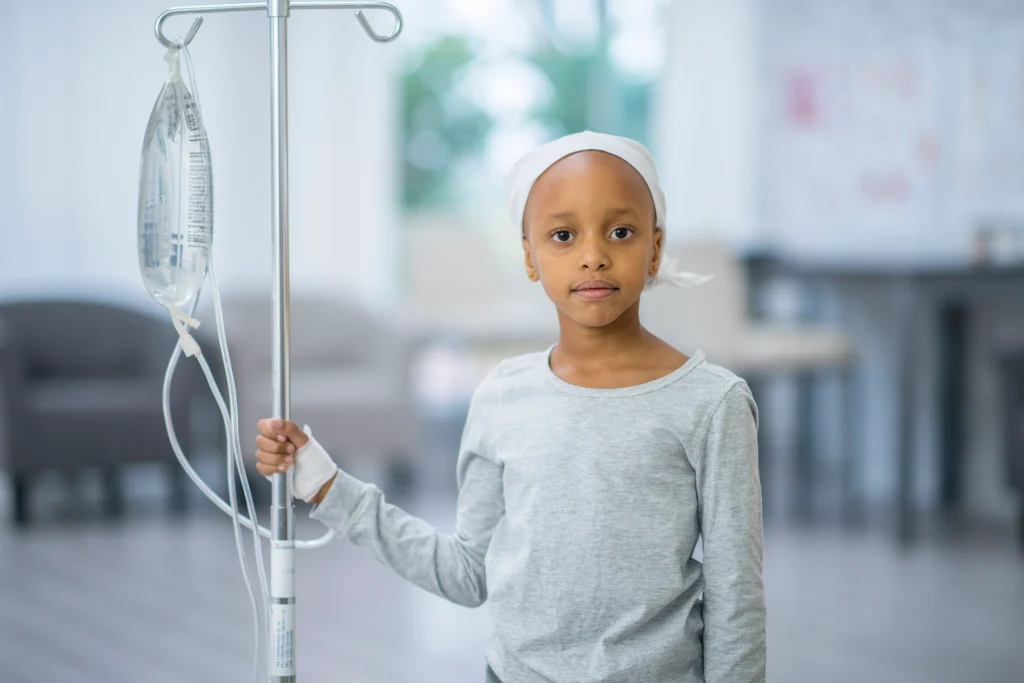Last Updated on November 13, 2025 by
What is causing childhood cancer? Genetic errors happen when DNA is copied incorrectly during cell division. This leads to changes, from small typos to big DNA rearrangements. These changes can cause serious diseases, like cancer.

The DNA replication process is complex. Errors can come from many sources, like environmental factors and the DNA copying machine’s flaws. Over time, these genetic mutations build up. They can make a person more likely to get certain health problems.
Cells divide and grow, copying their DNA. But sometimes, this copying goes wrong, leading to genetic errors. These errors, or mutations, can happen for many reasons, like mistakes during DNA copying or exposure to harmful substances.
DNA replication is a complex process. It involves many enzymes and molecular machinery. Even with its high accuracy, errors can occur.
For example, the DNA replication machinery might misread the template strand. This can lead to mismatched bases in the new DNA strand. External factors like radiation or chemical mutagens can make these errors worse.
Recent studies found that by middle age, each human cell has about 1,000 genetic mistakes. With 4 million cells dividing every second, the number of genetic errors is huge. This buildup of mutations over time is key to understanding how cancer starts.

The human body has trillions of cells, each with its own DNA. As cells divide, the chance of genetic errors grows. It’s estimated that every cell division brings a chance for mutations.
With age, the number of mutations in cells can increase a lot. This can lead to diseases, including cancer. Understanding how many mutations happen in human cells is vital for seeing how genetic errors cause disease.
The fact that about 4 million cells divide every second shows the huge chance for genetic mistakes. As we get older, these mistakes can pile up, causing cancer and other health problems.
It’s important to know about different genetic errors and how they affect our health. These errors can take many forms. While some are harmless, others can lead to serious diseases like cancer or neurodegenerative conditions.
Single-nucleotide polymorphisms (SNPs) are common genetic variations. They are like small “typos” in our DNA, where just one nucleotide base is changed. These changes can sometimes cause genetic disorders or raise the risk of certain diseases.
Deletions and insertions are mutations that change the amount of genetic material. These changes can mess up how genes work. For example, some deletions can cause developmental disorders, while insertions might lead to cancer.
Chromosomal rearrangements happen when DNA breaks and then rearranges itself. This can cause genetic disorders because it messes with the normal structure and function of genes. Such rearrangements are often seen in conditions like leukemia.
Structural variants, like deletions, duplications, and inversions, can greatly affect gene function. Studies show that these variants might cause 1%“6% of pediatric solid tumors. Understanding these variants is key to finding the genetic roots of diseases and creating targeted treatments.
The variety of genetic errors shows how complex genetic diseases are. By studying these mutations, researchers can learn more about the causes of diseases like cancer. This knowledge helps in developing better treatments.
Genetic mutations are a big part of childhood cancer. But why these mutations happen is not clear yet. They can come from random changes or things in the environment.

Some kids get cancer because of genetic mistakes early in life. Research shows that some kids are born with these mistakes. Others might get them later because of their surroundings or chance.
It’s key to know why some kids get cancer and others don’t. This helps us find better ways to prevent and treat it. Genetic tests can spot kids at high risk early, helping them get better sooner.
Some kids have way more genetic mistakes than usual. This is called hypermutation. It makes them more likely to get cancer because it messes with how cells work.
Studies say hypermutation often comes from random changes in the father’s sperm. This shows how important it is to understand the genetic side of childhood cancer.
Some babies are born with cancer, known as congenital cancer. Genetic mistakes during fetal growth can cause it.
Learning about the genetic reasons for congenital cancer helps us fight it better. Genetic tests can find the causes of congenital cancer. This lets us target treatments and improve chances of survival.
Exploring the origins of harmful genetic mutations shows us how they form. These mutations come from chance and certain genetic actions.
Studies show that random mutations in sperm cells from men can lead to genetic errors. As men get older, more mutations appear in their sperm. This raises the chance of passing on harmful mutations to their kids.
Sperm cells divide many times in a man’s life. This gives many chances for DNA mistakes to happen. These mistakes can increase the risk of genetic diseases.
Asking if humans came from genetic mistakes links to evolution. Mutations drive evolution, helping species adapt and change over time.
The genetic code, almost the same in all living things, is not perfect. Yet, these mistakes help create the variety of life on Earth. Learning about genetic mutations in evolution helps us understand humanity and the human genome.
In summary, harmful genetic mutations come from chance and genetic processes. Looking at random mutations in sperm cells and genetic errors helps us understand human genetics better.
Genetic errors come from a mix of environmental triggers and random chance. This debate is key to understanding cancer, mainly in kids.
Research has shown how environmental exposures lead to genetic mutations. These include radiation, chemicals, and lifestyle choices.
Some environmental factors raise the risk of genetic mutations. These include:
These exposures can damage DNA, leading to genetic errors. Studies link some of these exposures to a higher cancer risk, mainly in children.
Why some get cancer and others don’t is complex. It’s a mix of genetic predisposition, environmental factors, and chance.
A top cancer researcher said,
“The majority of cancers are due to random mutations, not environmental or hereditary factors.”
This shows how complex cancer causation is.
Understanding the mix of environmental triggers and chance is key to fighting cancer. By tackling risk factors, we can lower cancer rates.
DNA damage can stick around and grow, raising the risk of harmful genetic mutations. When DNA gets damaged, the cell tries to fix it. But if it can’t, it might lead to mutations that cause cancer.
The lasting nature of DNA damage is key to understanding genetic errors. Unfixed DNA damage can stay for two to three years. This long time allows mutations to build up, which can cause cancer.
Research shows that unrepaired DNA damage can stick around for a long time. This is bad because it raises the chance of genetic mutations. When DNA damage stays unrepaired for two to three years, the risk of cancer grows.
Studies reveal that up to 20% of mutations in blood stem cells come from long-lasting DNA damage. Blood stem cells are vital for making blood cells. Mutations in these cells can cause blood disorders, like leukemia.
Mutations in DNA can cause cancer through a complex process. When DNA damage isn’t fixed, it can lead to mutations that mess up cell function. These mutations can pile up and help cancer grow. Knowing how DNA damage persists and grows is key to fighting cancer.
In short, the lasting and growing nature of DNA damage is a big part of how genetic mutations and cancer happen. By understanding this, researchers can find new ways to stop and treat cancer.
To prevent and detect genetic errors early, we need to understand their causes and risk factors. By tackling these, we can lower the risk of cancer and other genetic diseases.
One key way to prevent genetic errors is to avoid known risk factors. This means staying away from harmful toxins, living a healthy lifestyle, and knowing your genetic risks. For example, knowing what is causing childhood cancer helps parents and doctors take steps to prevent it.
Studies show that some environmental factors can cause genetic mutations. By cutting down on these exposures, we can reduce the risk of genetic errors. Also, eating well and living healthily helps keep our genes in good shape.
Genetic testing and counseling are key to spotting people at risk of genetic mutations. They give insights into our genetic risk for certain diseases, helping us act early. For those asking why do some people get cancer and others don’t, genetic testing can provide answers.
Knowing our genetic risks lets us make better health choices. This might mean more screenings or specific preventive steps based on our genes.
The genetics field is growing fast, with new treatments that aim at genetic errors. These treatments could help treat and maybe even prevent diseases caused by genetic mutations.
Scientists are looking into gene editing and targeted therapies to fix or lessen genetic errors. These new methods are vital for better care for those with genetic disorders.
In summary, to fight and catch genetic errors early, we need a mix of strategies. This includes lowering risk factors, using genetic testing and counseling, and keeping up with new treatments. By doing these things, we can greatly boost our genetic health.
Understanding genetic errors is key to finding out why diseases like cancer happen. Studies show that genetic mutations can happen by chance or because of the environment. This makes us wonder if humans were a mistake in genetics.
It’s very important to keep studying genetic errors. By learning more about them and how they cause disease, scientists can find new ways to prevent and treat illnesses.
New treatments that target genetic errors are showing great promise. As research gets better, we’ll likely see big advances in diagnosing and treating diseases.
The future of genetic research looks bright. It could lead to major changes in how we understand and deal with health and disease.
The idea that humans might be a result of genetic error is part of a bigger evolution story. Over millions of years, genetic mutations have shaped our species. Some mutations harm us, but others help us adapt and diversify.
Cancer’s development is influenced by genetics, environment, and lifestyle. Some people might be more prone to genetic mutations. Others might be less likely to get cancer due to their genes or protective factors.
Babies with cancer often have genetic mutations that happen during fetal development. These can come from parents or random DNA errors. Sometimes, environmental factors during pregnancy also play a role.
DNA mutations can disrupt normal cell growth and division. If a mutation affects a gene that controls cell growth, it can cause cells to grow out of control. This leads to cancer.
Hypermutation means having a lot of genetic mutations in DNA. In childhood cancer, it increases the chance of mutations in genes that control cell growth. This can lead to cancer.
Childhood cancer is influenced by genetics and environment. Some kids might be more prone to genetic mutations. Others might be less likely due to their genes or protective factors.
Environmental exposures like radiation, chemicals, and viruses can cause DNA damage. This damage can lead to genetic mutations and raise cancer risk.
Genetic testing and counseling can spot people at risk of genetic mutations and cancer. Healthcare providers can then use early detection and prevention strategies. This includes regular screening and risk-reducing interventions.
New therapies include gene editing like CRISPR/Cas9 and targeted therapies for specific mutations. These could change how we treat cancer and other genetic diseases.
Subscribe to our e-newsletter to stay informed about the latest innovations in the world of health and exclusive offers!